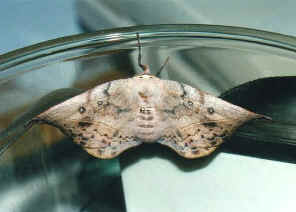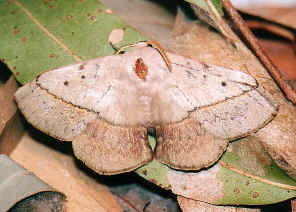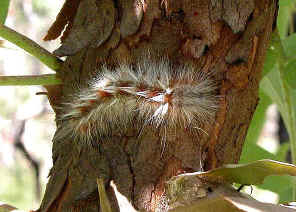Anthelid Moths - Family Anthelidae
The Anthelid Moths can be found only in Australia and New Guinea. They are common in Brisbane.

- Hairy Mary Caterpillar
The Caterpillars are from medium to very large size. They are very hairy, and the hairs may cause skin irritation if in contact. Their heads are large, and usually have the wearing sunglass look. The Caterpillars usually feed at night but some are active on day time. When rest, they hiding under bark or leaf.
The ANTHELIDAE caterpillars are easy to rear. Just feed them with the plants on which you find them, some may need a humid atmosphere when they become mature and pupate. Next time when you find the caterpillars, keep them and see what moths they will turn into.
The ANTHELIDAE pupate in a woven cocoon covered with plants materials. Most ANTHELIDAE moths fly at night. They have stout hairy body and board wings.
The
adults are small to very large moths. They usually with hairy thorax and
board wings.
- Anthelid Moth


- Anthela sp, caterpillar 50mm, moth wingspan 70mm
- We found the hairy caterpillar on the palm tree in our front yard in late summer. We kept it in a bottle with some palm leaf. After a few days, it turned into a silk cocoon. The cocoon was dark brown in colour, formed on the bottom of the bottle covered by the palm leaf. About four weeks later, we saw a light brown moth came out. It flied away after we took some photos. We sometimes see this Varied Anthelid Moth coming to our windows at night. Click here for more details.
- Anthelid Moth

- Anthela sp., wingspan 70mm
- In early summer 2003, we found a large woven cocoon, about 20x40mm, attached among the leaves on a young gum tree. We took it home and put it in a jar. About two weeks later, a moth came out as the above picture.
- Anthelid Moth


- ? sp., wingspan 70mm
- In late summer 2005, we found this moth crawling inside our house. When we saw the moth, it could not fly yet and did not walk very well. We believe it just came out from pupa. This might be the caterpillar we collected few weeks ago but escarped from the captivity and pupated somewhere inside our house. This moth look the same as the on above but pinkish-brown in colour. They may be the same species.
- Eyespot Anthelid

- Anthela ocellata, body length 30mm
- Pictures taken on the wall outside our house.
- Hairy Mary Caterpillar


- Anthela varia 90mm
- 35mm Hairy caterpillar feeding on gum tree leaf. One week later, at same area found another similar caterpillar, with 90mm in length. The caterpillar body is dark brown to black in colour, with long white hair. Notice there are two row of white spots on its back. The second picture shows it head, it is feeding on gum tree leaf.

- Above picture taken in Karawatha Forest during mid summer.
- Anthelid Caterpillar on Gum tree trunk


- ? sp., length 50mm
- Anthelid Caterpillar


- Anthela sp. length 50mm Anthela sp. length 30mm
- Caterpillars found on gum tree leaf in late summer.
- Caterpillar with black hair on Acacia

- ? sp., length 30mm found on Acacia leaf in late summer.

